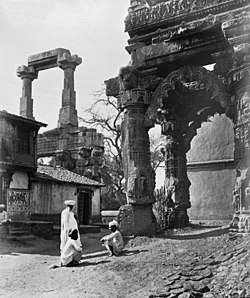

| Rudra Mahalaya Temple | |||||||||||||||
|---|---|---|---|---|---|---|---|---|---|---|---|---|---|---|---|

Ruins of main portal, Toran, of Rudra Mahalaya, 1874
| |||||||||||||||
|
Location in Gujarat | |||||||||||||||
| Alternative names | Rudra Mala | ||||||||||||||
| General information | |||||||||||||||
| Status | ruined | ||||||||||||||
| Architectural style | Māru-Gurjara architecture | ||||||||||||||
| Location | Siddhpur, Patan district, Gujarat | ||||||||||||||
| Country | India | ||||||||||||||
| Coordinates | 23°55′09″N 72°22′45″E / 23.91917°N 72.37917°E / 23.91917; 72.37917 | ||||||||||||||
| Construction started | 943 CE | ||||||||||||||
| Opened | 1140 CE | ||||||||||||||
| Destroyed | 1296 CE and 1414 CE | ||||||||||||||
| Technical details | |||||||||||||||
| Material | sandstone | ||||||||||||||
| Floor count | 2 | ||||||||||||||
| Designations | ASI Monument of National Importance (N-GJ-164 for temple/163 for mosque) | ||||||||||||||
| |||||||||||||||
The Rudra Mahalaya Temple, also known as Rudramal, is a destroyed/desecrated Hindu temple complex at Siddhpur in the Patan districtofGujarat, India. Its construction was started in 943 CE by Mularaja and completed in 1140 CE by Jayasimha Siddharaja, a ruler of the Chaulukya dynasty. The Hindu temple was destroyed by the Sultan of Delhi, Alauddin Khalji, and later the Sultan of Gujarat, Ahmed Shah I (1410–1444) desecrated and substantially demolished the temple, and also converted part of it into the congregational mosque (Jami Masjid) of the city. Two torans (porches) and four pillars of the former central structure still stand along with the western part of the complex used as a congregational mosque.

Sidhpur, under the rulers of Chaulukya dynasty, was a prominent town in the tenth century. An inscription from 986-987 CE mentions in passing that Mularaja, the founder of the Chaulukya dynasty of Gujarat, had offered prayers to Rudra Mahalay. Colonial sources say that Muladev ordered the construction of a shrine there to atone for his earlier sins,[1] but it is possible that a temple existed at the place even before his reign. Archaeological evidence suggests that an existing structure was removed and a new complex was built on top of the existing foundation in twelfth century.[2]
It was during the 12th century, in 1140 CE, that Jayasimha Siddharaja (1094–1144) consecrated the temple complex in worship of Shiva.[1][a][b] This act continued the long-running patronage of the city by the Chalukyas.[2]
The temple was dismantled during the siege of the city by Ahmad Shah I (1410–44) of Muzaffarid dynasty; parts of it were reused in setting up a new congregational mosque.[2] Mirat-i-Sikandiri, the earliest extant chronicle in Persian documenting Shah's campaigns, attributes the destruction to religious zealotry[c] — however, Alka Patel cautions that these texts were often biased due to panegyric aims and often contradicted by other evidence.[2]
The temple was built in Māru-Gurjara architecture style.